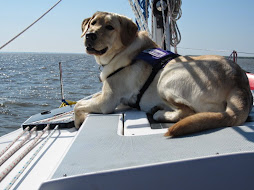 SSD Coriander will begin her advanced training at the SSD kennel on July 6. She's a real sweetheart and we're very excited for her to start her training. She will leave her puppy raiser family, where she has spent most of her life, and start learning the advanced skills she'll need to one day assist her partner.
SSD Coriander will begin her advanced training at the SSD kennel on July 6. She's a real sweetheart and we're very excited for her to start her training. She will leave her puppy raiser family, where she has spent most of her life, and start learning the advanced skills she'll need to one day assist her partner.Coriander's success in advanced training is greatly increased because of the solid foundation of behaviors and skills she gained from her time with her puppy raiser family. Although a dog's success in advanced training and as a service dog does not necessarily depend on their puppy raiser's ability to train them, the puppy raisers do give the dog a foundation of skills and behaviors that are essential to their success in advanced training. In fact, dogs that receive this foundation tend to complete their advanced training more quickly.

SSD has been blessed with a wonderful group of puppy raisers. Our puppy raisers are volunteers who donate their time and love to a puppy that will live with them for 15 to 18 months. We depend on these volunteers because, as the name "puppy raiser" suggests, they raise the puppies during the time when they are young and learn new behaviors easily. If you have a dog of your own, you probably know that it's easier to teach young puppies than it is to train older dogs, though it's certainly not impossible to teach an older dog new tricks!
Puppy raisers are responsible for the early training of the puppies. They expose puppies to as many new experiences as possible to both increase their learning capacity and to get them used to performing behaviors in any environment. Puppy raiser responsibilities include:
- lots of daily exercise
- housebreaking
- car rides
- walks in populated places
- walks in parks and forests
- visits to new and interesting places
- visits to meetings (so puppy learns to wait quietly)
- regular attendence at SSD puppy classes
- special games several times a week
But even more than that, the job of the puppy raisers is to give the puppies lots of love.
Check out these blogs written by some of our puppy raisers:
It's possible for anyone to become a puppy raiser for SSD. You do not need to have previous experience training dogs. You just need to love animals, have an open mind, be willing to learn, and be positive, patient, inquisitive and generous. We can train you to train an SSD puppy. However, we do have certain criteria that we look for in our puppy raisers. In our next post, we'll share some of the things we look for in our puppy raisers and how you can apply to become one.









